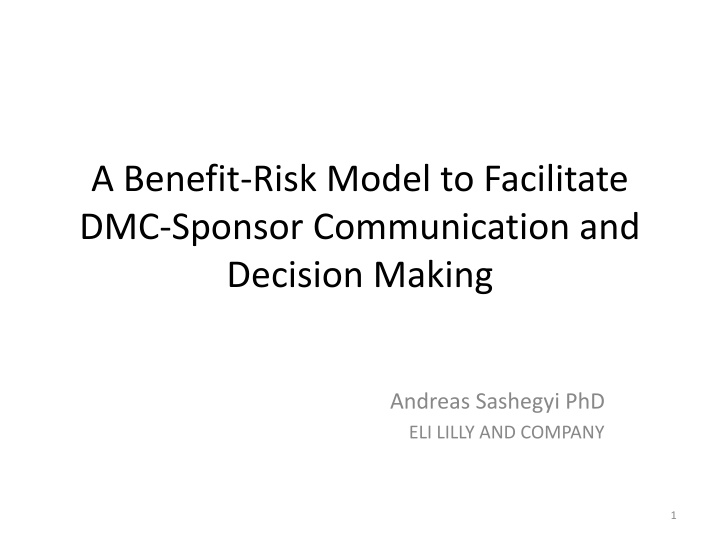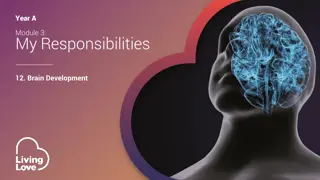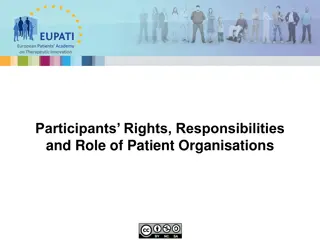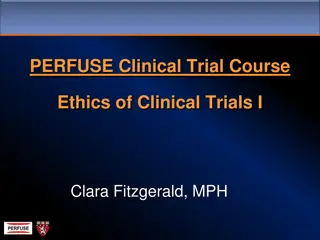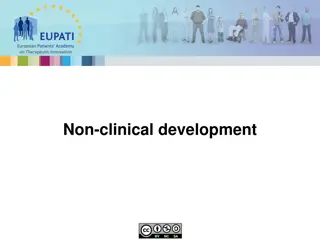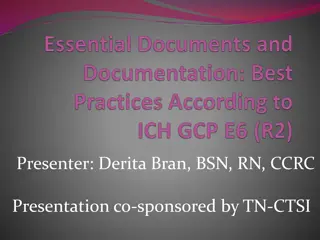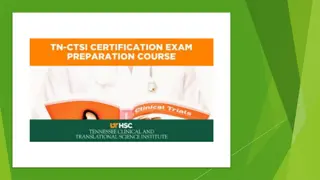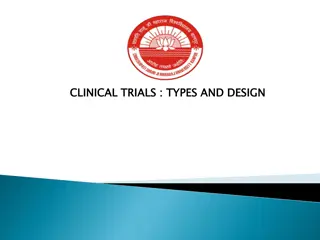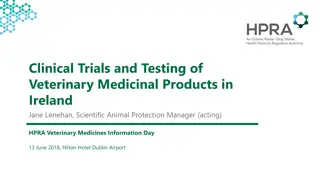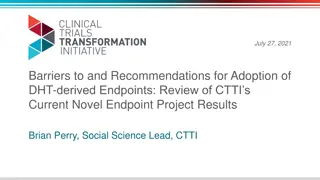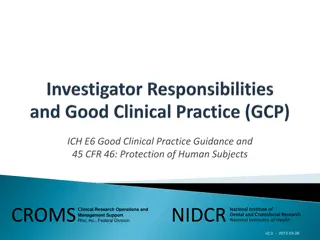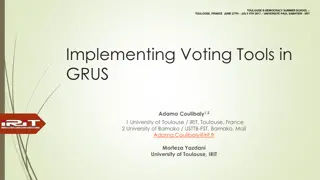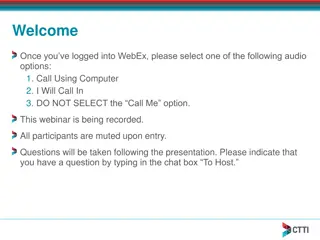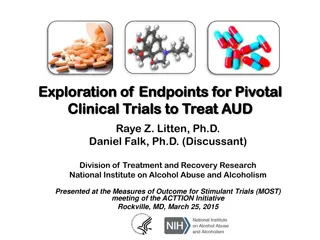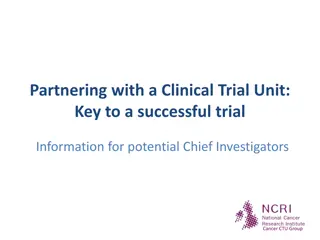Effective Communication and Decision Making in Clinical Trials
Explore the challenges faced by Data Monitoring Committees (DMCs) in communicating emerging benefit-risk assessments to sponsors without revealing study results. Learn about the importance of conveying key trial data to sponsors for informed decision-making while maintaining study blinding. Discover the use of a Benefit-Risk Assessment Model (BRAM) to aid in evaluating benefit-risk profiles effectively.
Download Presentation

Please find below an Image/Link to download the presentation.
The content on the website is provided AS IS for your information and personal use only. It may not be sold, licensed, or shared on other websites without obtaining consent from the author.If you encounter any issues during the download, it is possible that the publisher has removed the file from their server.
You are allowed to download the files provided on this website for personal or commercial use, subject to the condition that they are used lawfully. All files are the property of their respective owners.
The content on the website is provided AS IS for your information and personal use only. It may not be sold, licensed, or shared on other websites without obtaining consent from the author.
E N D
Presentation Transcript
A Benefit-Risk Model to Facilitate DMC-Sponsor Communication and Decision Making Andreas Sashegyi PhD ELI LILLY AND COMPANY 1
Picture the Following Scenario DMC of a landmark Phase 3 clinical trial meets to review accumulating data of the study, just past the half-way point Committee agrees that emerging benefit looks real and promising Risk profile of the compound is more severe than expected DMC reviews ICD and DMC Charter to determine what degree of risk tolerance was specified and concludes that it is not unethical to continue trial; no additional guidance specified DMC believes the study could continue, but does not know whether sponsor would agree The committee s deliberations are stalled in absence of knowing how sponsor would assess benefit-risk balance Is there a way of communicating emerging benefit-risk balance to the sponsor without unblinding study results? 2
The Dilemma Independent DMCs are intentionally engaged for pivotal trials to monitor patient safety, allowing sponsor to remain blinded to data DMC makes recommendations based on emerging data, but Sponsor called to make decisions without recourse to these data Is such decision making always feasible? 3
Requirements for a Resolution At times a sponsor should be informed of certain key features of the emerging trial data (beyond a terse DMC recommendation) in order to make a good decision concerning the continuing conduct of the study The information conveyed may not reveal any specifics about trial endpoints or other study measurements, so as to protect study blinding The information conveyed should allow an assessment of whether emerging risks for patients are tolerable in view of accruing benefits 4
A Benefit-Risk Assessment Model (BRAM) Consider application of a multi-attribute model for evaluating benefit-risk profiles (Felli, Noel & Cavazzoni, Medical Decision Making, 2009) BRAM graphically presents contextual beliefs about benefits and risks in a framework conducive to focused discussion Requires definition of an analytic frame Disease State = Disease being studied by the trial in question Population of Interest = Study participants Perspective for Assessments and Tradeoffs = DMC, focused on patient safety 5
Model Structure V Risk Benefit Primary endpoint Safety Efficacy Safety Measure 1 : Efficacy Measure 1 : Safety Measure nS Efficacy Measure nE Assessed with other efficacy measures Tolerability Tolerability Measure 1 : Life Effects Life Effect 1 : Tolerability Measure nT Life Effect nL In the context of key safety and other Risk measures Improper Use Convenience Treatment Administration Treatment Burden Monitoring Acquisition Storage Along with other Benefit attributes 6
Evaluation Weights are chosen to reflect relative importance of each benefit and risk attribute (sum to 1 within each dimension) to reflect relative importance of each measure within an attribute (sum to 1 within each attribute) Attributes are scored, based on accumulating interim data Normalized to lie between 0 and 1 Convention: more advantageous benefit and more detrimental risk ratings correspond to higher values (i.e. would like to see benefit scores as close to 1 and risk scores as close to 0 as possible) 7
Evaluation Aggregate scores are computed for the 2 risk and 3 benefit attributes (weighted averages of the measures within the various attributes) for the overall benefit and risk dimensions of the model (weighted averages of the various attributes) Result is a generic (x, y) pair depicting a position on a benefit (y) risk (x) plane P = [0,1]x[0,1] Of interest is the position of the evaluation of the experimental therapy relative to control 8
Model Structure V Risk Benefit w1 w1 Safety Efficacy w1 w1 Score 1 : Score 1 : Score nE wnS wnE Score nS [0, 1] w2 w2 Tolerability w1 Life Effects w1 Score 1 : Score 1 : wnT Score nT wnL Score nL [0, 1] w3 Improper Use Convenience w1 w2 w3 w4 w5 Score 1 Score 2 Score 3 Score 4 Score 5 Sum to 1.0 9
E.g. Diabetes Compound V Risk Benefit Score = 0.53 Score = 0.39 Risk 0.75 Benefit 0.70 0.48 Safety 0.55 Efficacy 0.30 0.83 HbA1c 0.10 0.70 Fasting Glucose 0.10 0.25 Tolerability 0.10 0.75 Insulin Sensitivity 0.20 0.28 Beta Cell Function 0.15 0.55 Lipid Profile 0.15 0.10 Weight Loss Improper Use 0.60 0.20 Life Effects 0.25 0.10 Convenience 10
BRAM Output 1.0 0.8 0.6 Benefit Active Is the increase in risk implied by active therapy over control justified in view of the anticipated benefit? 0.4 Control 0.2 0 0.2 0.4 0.6 0.8 1.0 Risk 11
In Practice Each DMC member assigns own scores (ideally a range based on uncertainty given data collected!) assigns own weights? evaluates active therapy and control Resampling from distribution of weights and scores observed across DMC members allows a reflection of the uncertainty in the benefit/risk assessment generates an BR cloud 12
Active treatment Placebo Continue study Is the benefit/risk trade-off acceptable? Stop study due to futility/ safety concerns 13
Benefit/risk trade-off acceptable? DMC members may not all agree May put DMC Chair in a difficult position Could involve sponsor in making decision Need not unblind sponsor Active treatment Placebo 1 5 2 3 4 5 4 2 3 1 14
Benefit Risk Archetypes Control Active Promising Treatment Fully Aligned DMC Promising Treatment Varying positions on B/R assessment among DMC members Benefit Benefit Risk More Difficult decision! DMC not aligned Involve sponsor? Risk Benefit Benefit Difficult decision! Fully Aligned DMC Involve sponsor? Risk Risk 15
Some Thoughts Could this kind of tool be useful in helping a DMC form a recommendation (say, in the face of disagreement) even if the BRAM output is not shared with the sponsor? In cases where the assessment is shared with the sponsor, should the links between the individual DMC members assessment of control and active therapy be revealed? Shows extent to which DMC members consistently rate high or low, regardless of therapy group Would highlight variation among DMC members assessments of the relative difference between active therapy and control 16
Reducing this to Practice At the DMC Organizational Meeting Sponsor discusses BRAM structure with DMC the attributes, including scoring protocols which objectively transform observed data to the unit interval Sponsor shares weights of the study team Sponsor discusses scenarios highlighting changes in benefit/risk scores with which the team would be comfortable or uncomfortable Agreement reached on how to incorporate new findings (e.g. unexpected side effect) BRAM structure and intended use captured in DMC Charter BRAM structure should not be altered by DMC during the conduct of the study With exception of incorporating new findings agreed upon process to be followed 17
Reducing this to Practice DMC statistician brings BRAM evaluation tool to meetings responsible for collecting scores and producing model output in real time Ultimately, we need DMC and sponsor to be comfortable with this approach Input from regulators Pilot the model 18
